lock MAZDA MODEL CX-9 2009 (in English) User Guide
[x] Cancel search | Manufacturer: MAZDA, Model Year: 2009, Model line: MODEL CX-9, Model: MAZDA MODEL CX-9 2009Pages: 538, PDF Size: 12.18 MB
Page 25 of 538
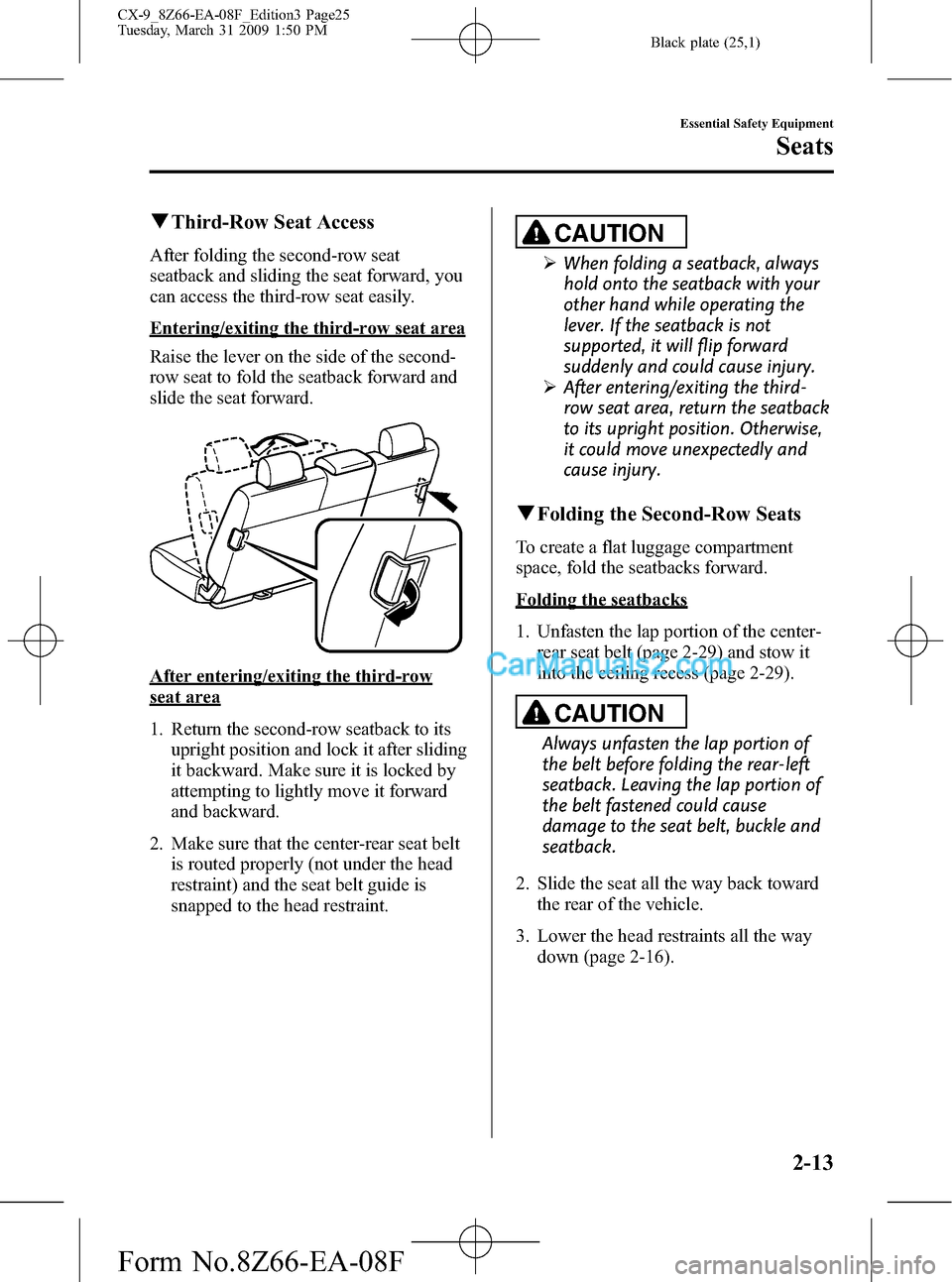
Black plate (25,1)
qThird-Row Seat Access
After folding the second-row seat
seatback and sliding the seat forward, you
can access the third-row seat easily.
Entering/exiting the third-row seat area
Raise the lever on the side of the second-
row seat to fold the seatback forward and
slide the seat forward.
After entering/exiting the third-row
seat area
1. Return the second-row seatback to its
upright position and lock it after sliding
it backward. Make sure it is locked by
attempting to lightly move it forward
and backward.
2. Make sure that the center-rear seat belt
is routed properly (not under the head
restraint) and the seat belt guide is
snapped to the head restraint.
CAUTION
ØWhen folding a seatback, always
hold onto the seatback with your
other hand while operating the
lever. If the seatback is not
supported, it will flip forward
suddenly and could cause injury.
ØAfter entering/exiting the third-
row seat area, return the seatback
to its upright position. Otherwise,
it could move unexpectedly and
cause injury.
qFolding the Second-Row Seats
To create a flat luggage compartment
space, fold the seatbacks forward.
Folding the seatbacks
1. Unfasten the lap portion of the center-
rear seat belt (page 2-29) and stow it
into the ceiling recess (page 2-29).
CAUTION
Always unfasten the lap portion of
the belt before folding the rear-left
seatback. Leaving the lap portion of
the belt fastened could cause
damage to the seat belt, buckle and
seatback.
2. Slide the seat all the way back toward
the rear of the vehicle.
3. Lower the head restraints all the way
down (page 2-16).
Essential Safety Equipment
Seats
2-13
CX-9_8Z66-EA-08F_Edition3 Page25
Tuesday, March 31 2009 1:50 PM
Form No.8Z66-EA-08F
Page 27 of 538
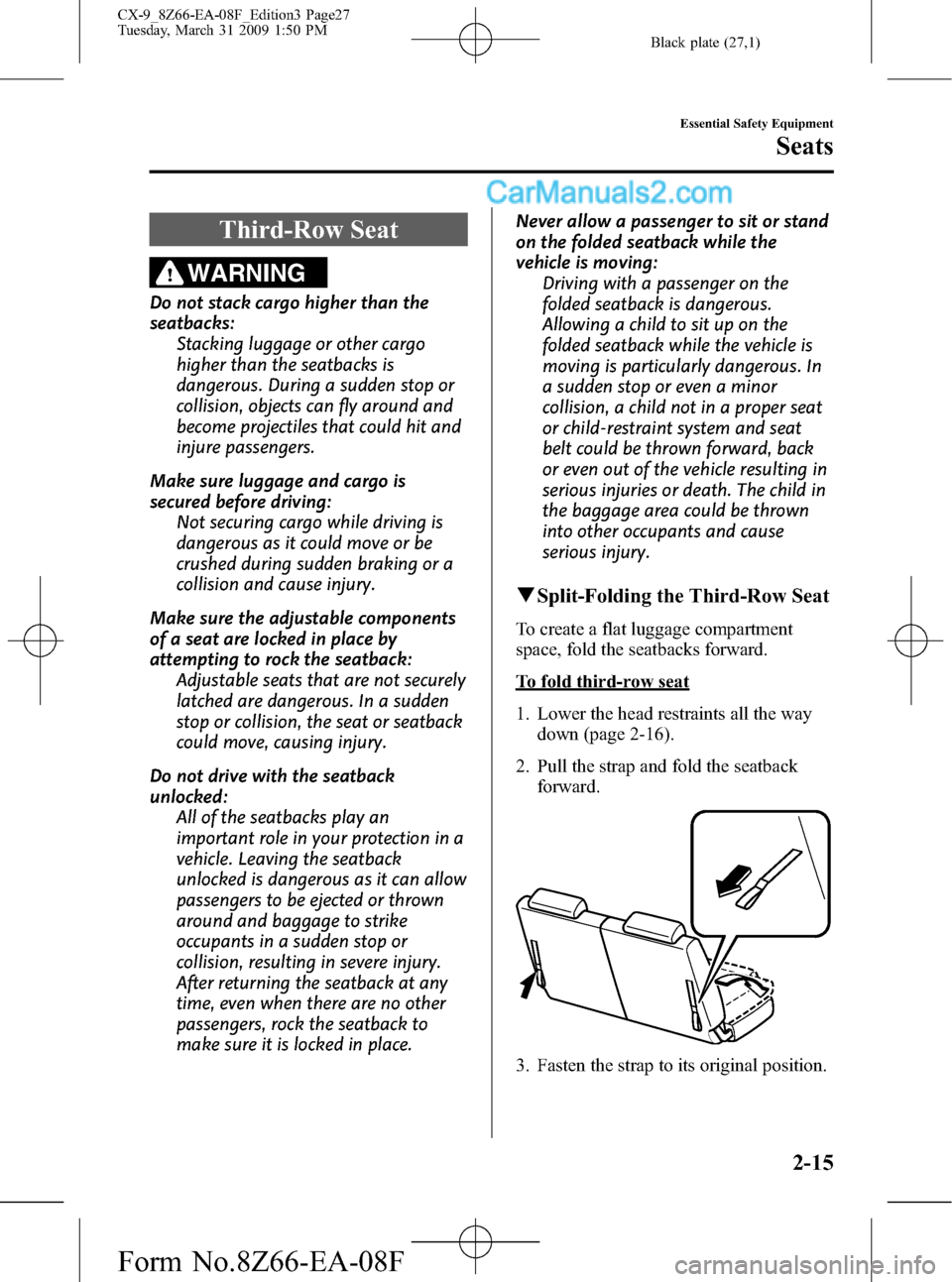
Black plate (27,1)
Third-Row Seat
WARNING
Do not stack cargo higher than the
seatbacks:
Stacking luggage or other cargo
higher than the seatbacks is
dangerous. During a sudden stop or
collision, objects can fly around and
become projectiles that could hit and
injure passengers.
Make sure luggage and cargo is
secured before driving:
Not securing cargo while driving is
dangerous as it could move or be
crushed during sudden braking or a
collision and cause injury.
Make sure the adjustable components
of a seat are locked in place by
attempting to rock the seatback:
Adjustable seats that are not securely
latched are dangerous. In a sudden
stop or collision, the seat or seatback
could move, causing injury.
Do not drive with the seatback
unlocked:
All of the seatbacks play an
important role in your protection in a
vehicle. Leaving the seatback
unlocked is dangerous as it can allow
passengers to be ejected or thrown
around and baggage to strike
occupants in a sudden stop or
collision, resulting in severe injury.
After returning the seatback at any
time, even when there are no other
passengers, rock the seatback to
make sure it is locked in place.Never allow a passenger to sit or stand
on the folded seatback while the
vehicle is moving:
Driving with a passenger on the
folded seatback is dangerous.
Allowing a child to sit up on the
folded seatback while the vehicle is
moving is particularly dangerous. In
a sudden stop or even a minor
collision, a child not in a proper seat
or child-restraint system and seat
belt could be thrown forward, back
or even out of the vehicle resulting in
serious injuries or death. The child in
the baggage area could be thrown
into other occupants and cause
serious injury.
qSplit-Folding the Third-Row Seat
To create a flat luggage compartment
space, fold the seatbacks forward.
To fold third-row seat
1. Lower the head restraints all the way
down (page 2-16).
2. Pull the strap and fold the seatback
forward.
3. Fasten the strap to its original position.
Essential Safety Equipment
Seats
2-15
CX-9_8Z66-EA-08F_Edition3 Page27
Tuesday, March 31 2009 1:50 PM
Form No.8Z66-EA-08F
Page 31 of 538
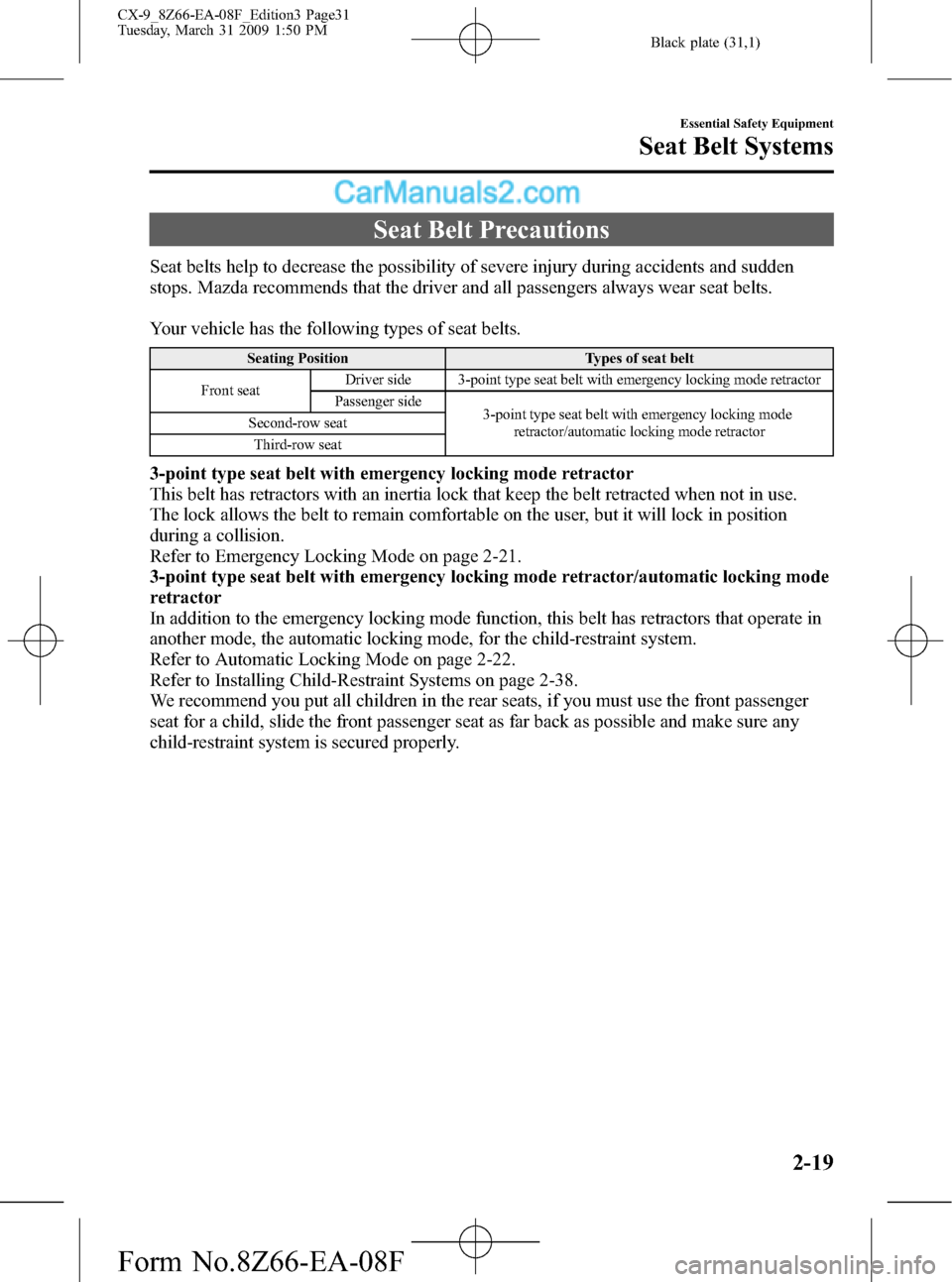
Black plate (31,1)
Seat Belt Precautions
Seat belts help to decrease the possibility of severe injury during accidents and sudden
stops. Mazda recommends that the driver and all passengers always wear seat belts.
Your vehicle has the following types of seat belts.
Seating Position Types of seat belt
Front seatDriver side 3-point type seat belt with emergency locking mode retractor
Passenger side
3-point type seat belt with emergency locking mode
retractor/automatic locking mode retractor Second-row seat
Third-row seat
3-point type seat belt with emergency locking mode retractor
This belt has retractors with an inertia lock that keep the belt retracted when not in use.
The lock allows the belt to remain comfortable on the user, but it will lock in position
during a collision.
Refer to Emergency Locking Mode on page 2-21.
3-point type seat belt with emergency locking mode retractor/automatic locking mode
retractor
In addition to the emergency locking mode function, this belt has retractors that operate in
another mode, the automatic locking mode, for the child-restraint system.
Refer to Automatic Locking Mode on page 2-22.
Refer to Installing Child-Restraint Systems on page 2-38.
We recommend you put all children in the rear seats, if you must use the front passenger
seat for a child, slide the front passenger seat as far back as possible and make sure any
child-restraint system is secured properly.
Essential Safety Equipment
Seat Belt Systems
2-19
CX-9_8Z66-EA-08F_Edition3 Page31
Tuesday, March 31 2009 1:50 PM
Form No.8Z66-EA-08F
Page 33 of 538
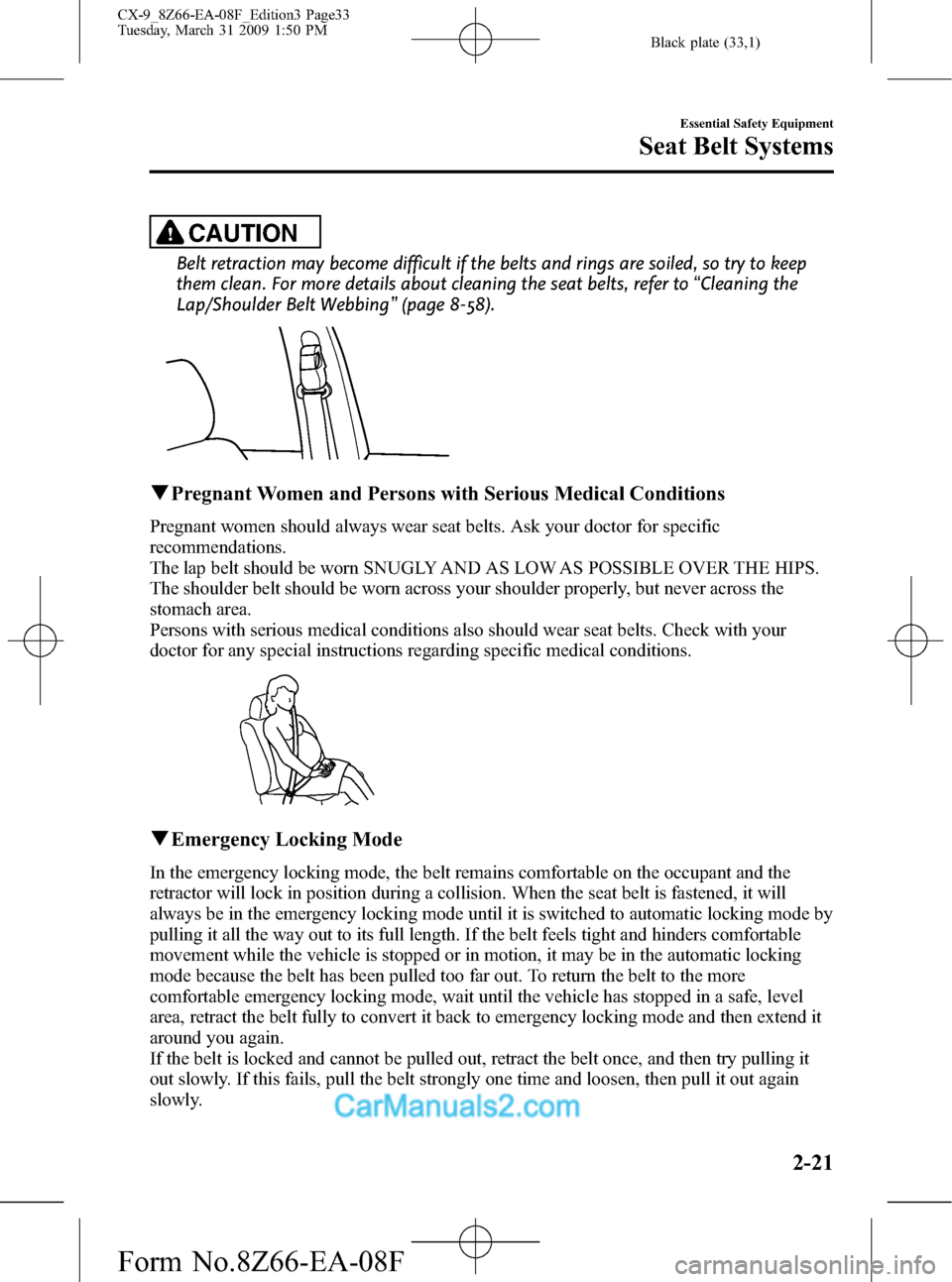
Black plate (33,1)
CAUTION
Belt retraction may become difficult if the belts and rings are soiled, so try to keep
them clean. For more details about cleaning the seat belts, refer to“Cleaning the
Lap/Shoulder Belt Webbing”(page 8-58).
qPregnant Women and Persons with Serious Medical Conditions
Pregnant women should always wear seat belts. Ask your doctor for specific
recommendations.
The lap belt should be worn SNUGLY AND AS LOW AS POSSIBLE OVER THE HIPS.
The shoulder belt should be worn across your shoulder properly, but never across the
stomach area.
Persons with serious medical conditions also should wear seat belts. Check with your
doctor for any special instructions regarding specific medical conditions.
qEmergency Locking Mode
In the emergency locking mode, the belt remains comfortable on the occupant and the
retractor will lock in position during a collision. When the seat belt is fastened, it will
always be in the emergency locking mode until it is switched to automatic locking mode by
pulling it all the way out to its full length. If the belt feels tight and hinders comfortable
movement while the vehicle is stopped or in motion, it may be in the automatic locking
mode because the belt has been pulled too far out. To return the belt to the more
comfortable emergency locking mode, wait until the vehicle has stopped in a safe, level
area, retract the belt fully to convert it back to emergency locking mode and then extend it
around you again.
If the belt is locked and cannot be pulled out, retract the belt once, and then try pulling it
out slowly. If this fails, pull the belt strongly one time and loosen, then pull it out again
slowly.
Essential Safety Equipment
Seat Belt Systems
2-21
CX-9_8Z66-EA-08F_Edition3 Page33
Tuesday, March 31 2009 1:50 PM
Form No.8Z66-EA-08F
Page 34 of 538
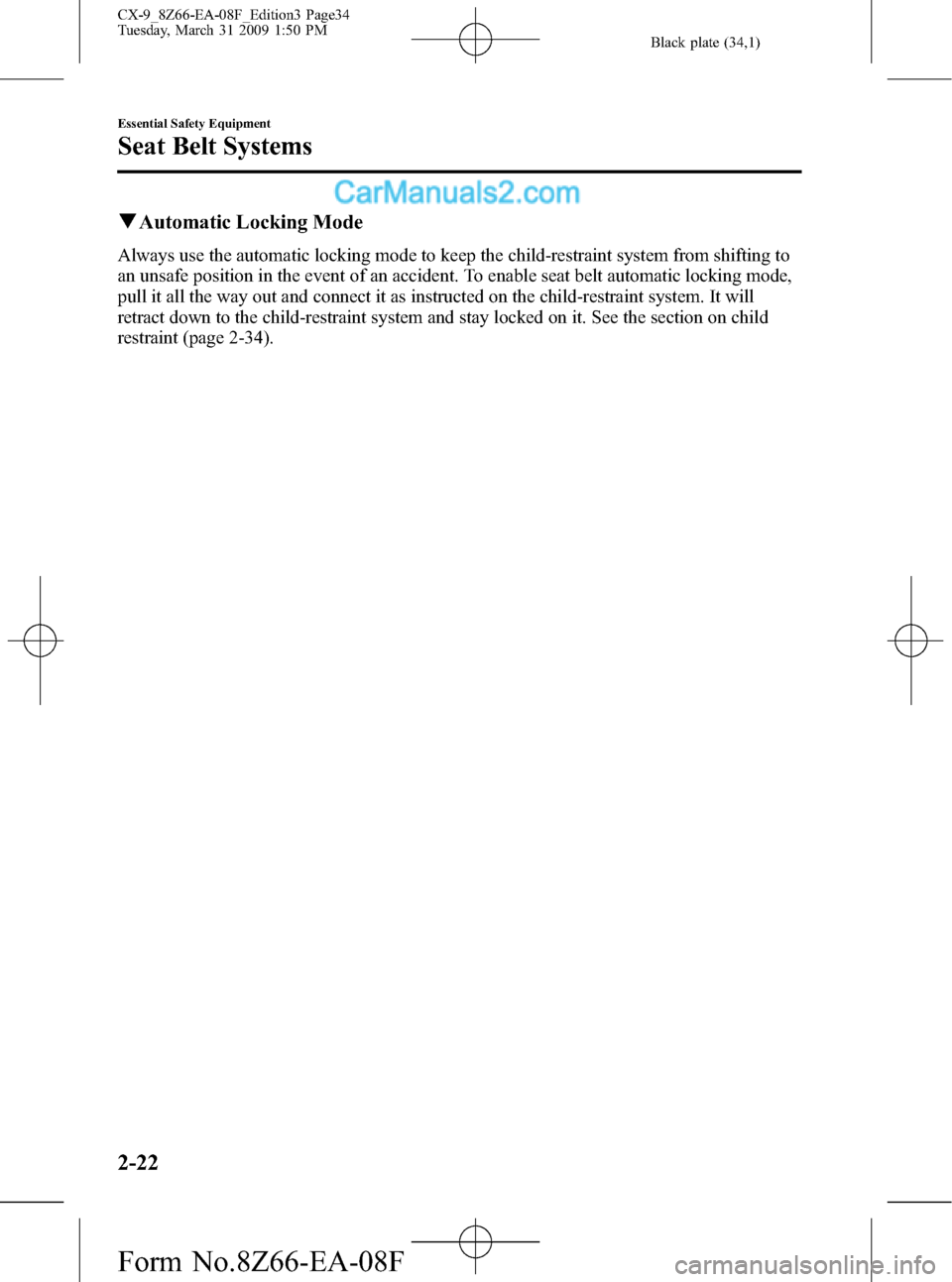
Black plate (34,1)
qAutomatic Locking Mode
Always use the automatic locking mode to keep the child-restraint system from shifting to
an unsafe position in the event of an accident. To enable seat belt automatic locking mode,
pull it all the way out and connect it as instructed on the child-restraint system. It will
retract down to the child-restraint system and stay locked on it. See the section on child
restraint (page 2-34).
2-22
Essential Safety Equipment
Seat Belt Systems
CX-9_8Z66-EA-08F_Edition3 Page34
Tuesday, March 31 2009 1:50 PM
Form No.8Z66-EA-08F
Page 36 of 538
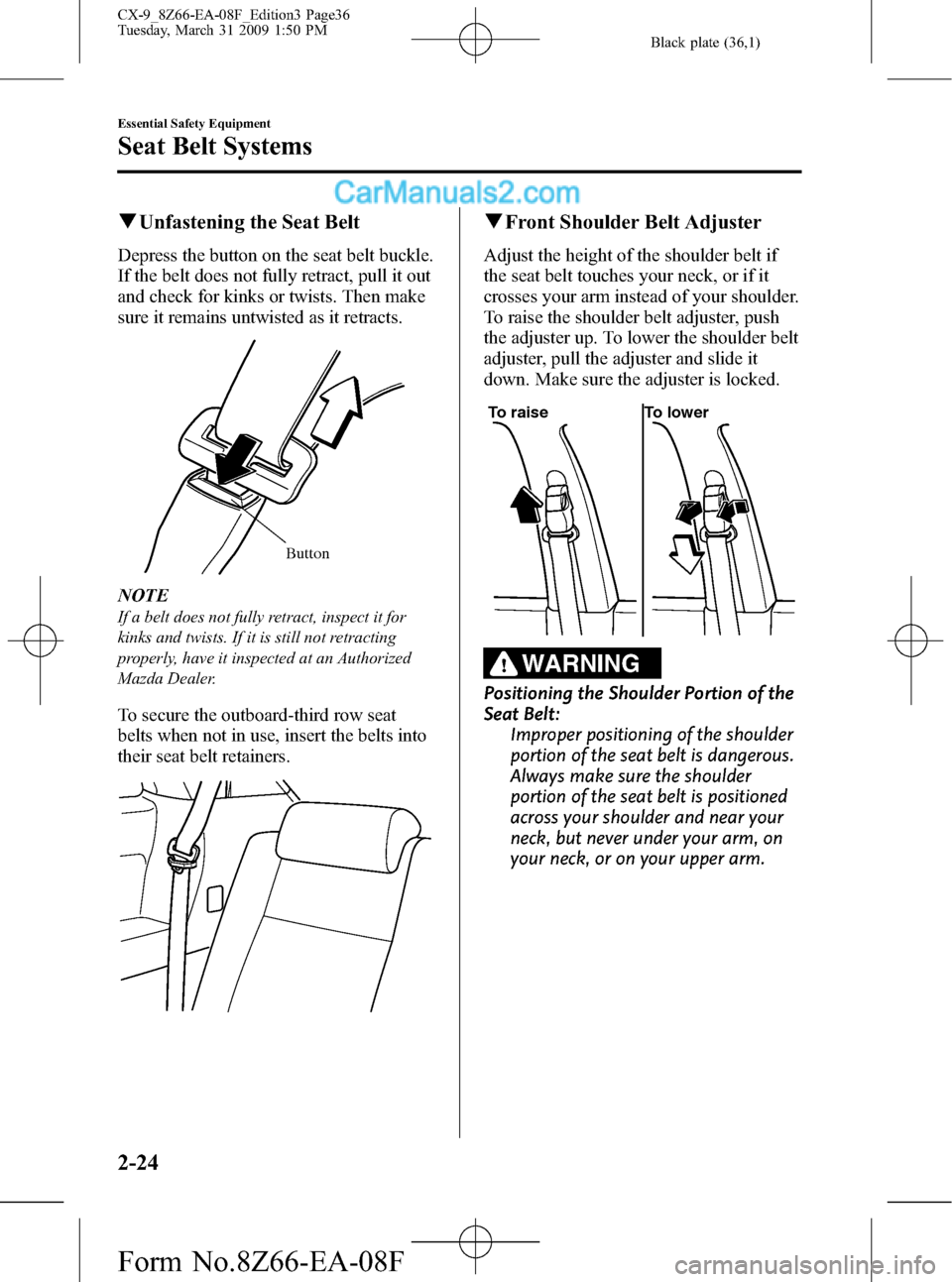
Black plate (36,1)
qUnfastening the Seat Belt
Depress the button on the seat belt buckle.
If the belt does not fully retract, pull it out
and check for kinks or twists. Then make
sure it remains untwisted as it retracts.
Button
NOTE
If a belt does not fully retract, inspect it for
kinks and twists. If it is still not retracting
properly, have it inspected at an Authorized
Mazda Dealer.
To secure the outboard-third row seat
belts when not in use, insert the belts into
their seat belt retainers.
qFront Shoulder Belt Adjuster
Adjust the height of the shoulder belt if
the seat belt touches your neck, or if it
crosses your arm instead of your shoulder.
To raise the shoulder belt adjuster, push
the adjuster up. To lower the shoulder belt
adjuster, pull the adjuster and slide it
down. Make sure the adjuster is locked.
To raise To lower
WARNING
Positioning the Shoulder Portion of the
Seat Belt:
Improper positioning of the shoulder
portion of the seat belt is dangerous.
Always make sure the shoulder
portion of the seat belt is positioned
across your shoulder and near your
neck, but never under your arm, on
your neck, or on your upper arm.
2-24
Essential Safety Equipment
Seat Belt Systems
CX-9_8Z66-EA-08F_Edition3 Page36
Tuesday, March 31 2009 1:50 PM
Form No.8Z66-EA-08F
Page 41 of 538
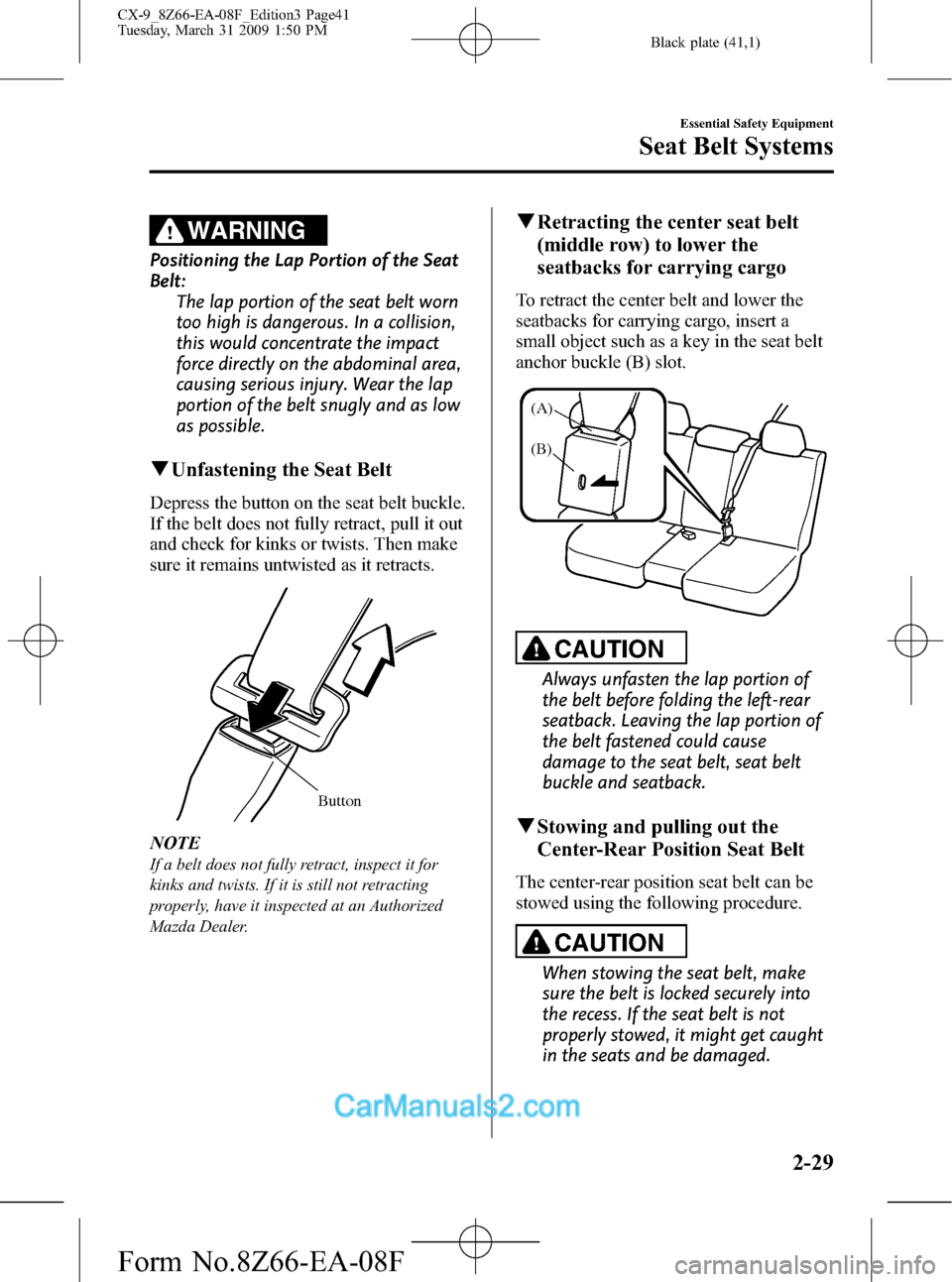
Black plate (41,1)
WARNING
Positioning the Lap Portion of the Seat
Belt:
The lap portion of the seat belt worn
too high is dangerous. In a collision,
this would concentrate the impact
force directly on the abdominal area,
causing serious injury. Wear the lap
portion of the belt snugly and as low
as possible.
qUnfastening the Seat Belt
Depress the button on the seat belt buckle.
If the belt does not fully retract, pull it out
and check for kinks or twists. Then make
sure it remains untwisted as it retracts.
Button
NOTE
If a belt does not fully retract, inspect it for
kinks and twists. If it is still not retracting
properly, have it inspected at an Authorized
Mazda Dealer.
qRetracting the center seat belt
(middle row) to lower the
seatbacks for carrying cargo
To retract the center belt and lower the
seatbacks for carrying cargo, insert a
small object such as a key in the seat belt
anchor buckle (B) slot.
(A)
(B)
CAUTION
Always unfasten the lap portion of
the belt before folding the left-rear
seatback. Leaving the lap portion of
the belt fastened could cause
damage to the seat belt, seat belt
buckle and seatback.
qStowing and pulling out the
Center-Rear Position Seat Belt
The center-rear position seat belt can be
stowed using the following procedure.
CAUTION
When stowing the seat belt, make
sure the belt is locked securely into
the recess. If the seat belt is not
properly stowed, it might get caught
in the seats and be damaged.
Essential Safety Equipment
Seat Belt Systems
2-29
CX-9_8Z66-EA-08F_Edition3 Page41
Tuesday, March 31 2009 1:50 PM
Form No.8Z66-EA-08F
Page 42 of 538
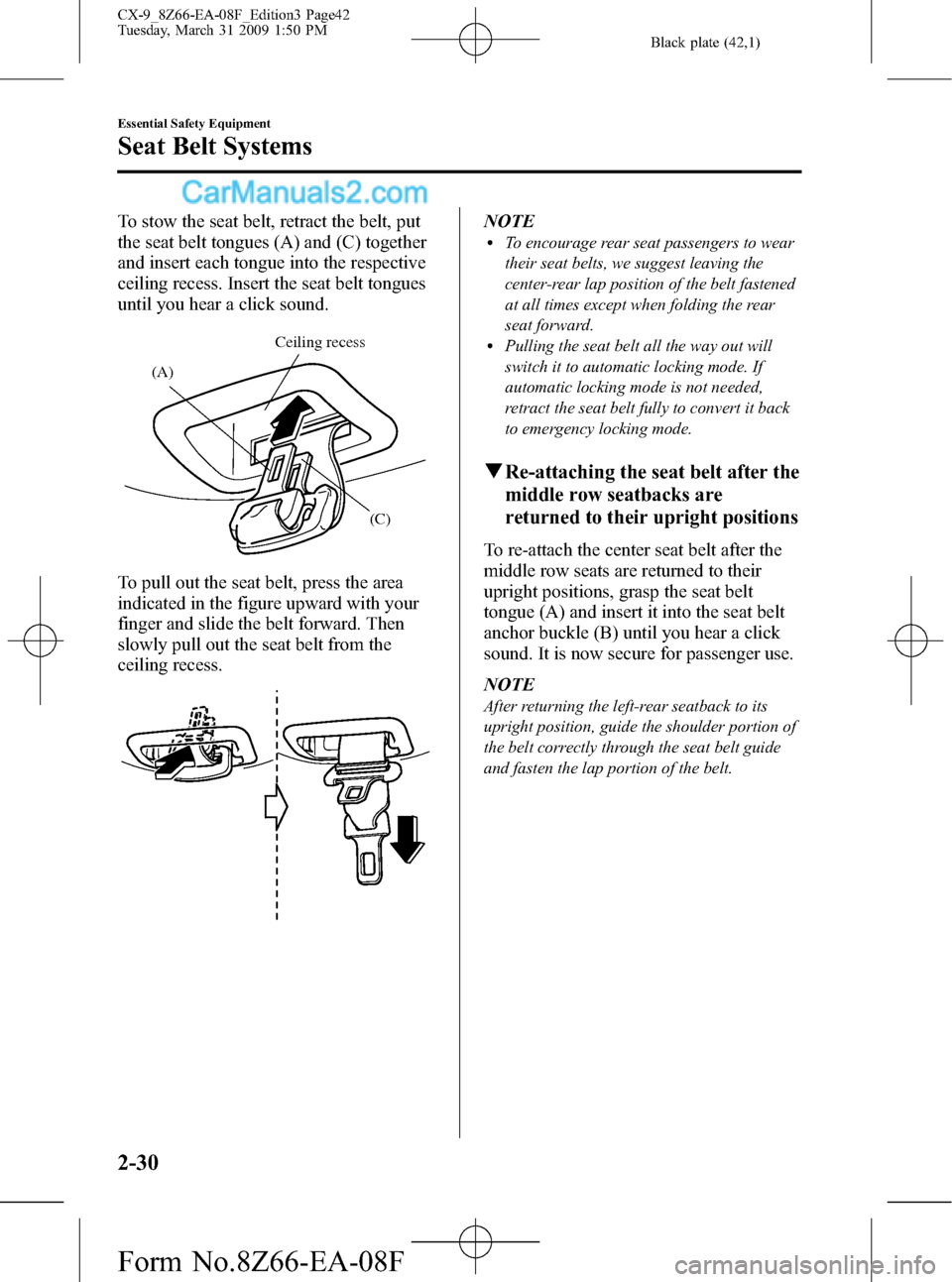
Black plate (42,1)
To stow the seat belt, retract the belt, put
the seat belt tongues (A) and (C) together
and insert each tongue into the respective
ceiling recess. Insert the seat belt tongues
until you hear a click sound.
(A)
(C) Ceiling recess
To pull out the seat belt, press the area
indicated in the figure upward with your
finger and slide the belt forward. Then
slowly pull out the seat belt from the
ceiling recess.
NOTElTo encourage rear seat passengers to wear
their seat belts, we suggest leaving the
center-rear lap position of the belt fastened
at all times except when folding the rear
seat forward.
lPulling the seat belt all the way out will
switch it to automatic locking mode. If
automatic locking mode is not needed,
retract the seat belt fully to convert it back
to emergency locking mode.
qRe-attaching the seat belt after the
middle row seatbacks are
returned to their upright positions
To re-attach the center seat belt after the
middle row seats are returned to their
upright positions, grasp the seat belt
tongue (A) and insert it into the seat belt
anchor buckle (B) until you hear a click
sound. It is now secure for passenger use.
NOTE
After returning the left-rear seatback to its
upright position, guide the shoulder portion of
the belt correctly through the seat belt guide
and fasten the lap portion of the belt.
2-30
Essential Safety Equipment
Seat Belt Systems
CX-9_8Z66-EA-08F_Edition3 Page42
Tuesday, March 31 2009 1:50 PM
Form No.8Z66-EA-08F
Page 49 of 538
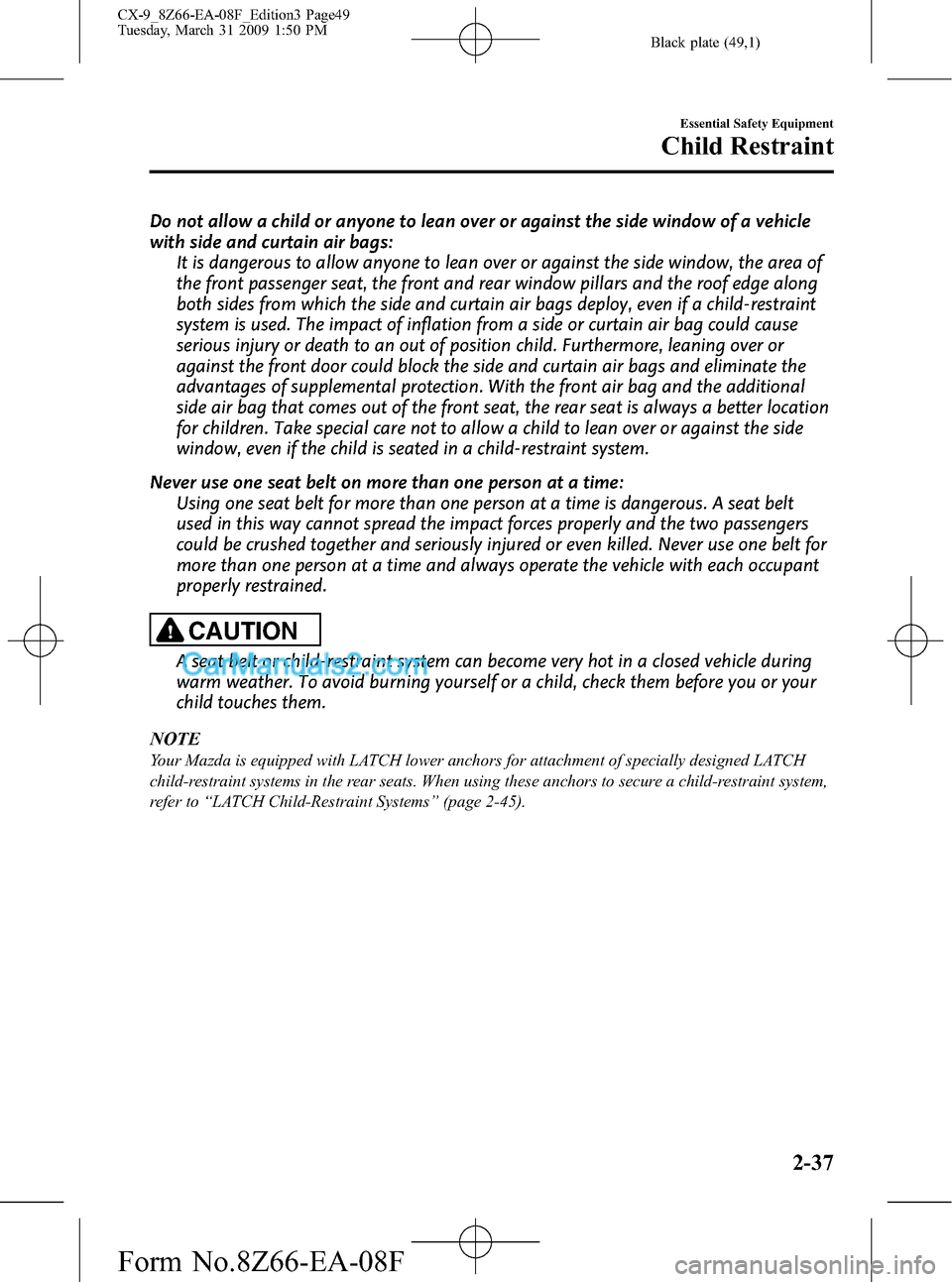
Black plate (49,1)
Do not allow a child or anyone to lean over or against the side window of a vehicle
with side and curtain air bags:
It is dangerous to allow anyone to lean over or against the side window, the area of
the front passenger seat, the front and rear window pillars and the roof edge along
both sides from which the side and curtain air bags deploy, even if a child-restraint
system is used. The impact of inflation from a side or curtain air bag could cause
serious injury or death to an out of position child. Furthermore, leaning over or
against the front door could block the side and curtain air bags and eliminate the
advantages of supplemental protection. With the front air bag and the additional
side air bag that comes out of the front seat, the rear seat is always a better location
for children. Take special care not to allow a child to lean over or against the side
window, even if the child is seated in a child-restraint system.
Never use one seat belt on more than one person at a time:
Using one seat belt for more than one person at a time is dangerous. A seat belt
used in this way cannot spread the impact forces properly and the two passengers
could be crushed together and seriously injured or even killed. Never use one belt for
more than one person at a time and always operate the vehicle with each occupant
properly restrained.
CAUTION
A seat belt or child-restraint system can become very hot in a closed vehicle during
warm weather. To avoid burning yourself or a child, check them before you or your
child touches them.
NOTE
Your Mazda is equipped with LATCH lower anchors for attachment of specially designed LATCH
child-restraint systems in the rear seats. When using these anchors to secure a child-restraint system,
refer to“LATCH Child-Restraint Systems”(page 2-45).
Essential Safety Equipment
Child Restraint
2-37
CX-9_8Z66-EA-08F_Edition3 Page49
Tuesday, March 31 2009 1:50 PM
Form No.8Z66-EA-08F
Page 50 of 538
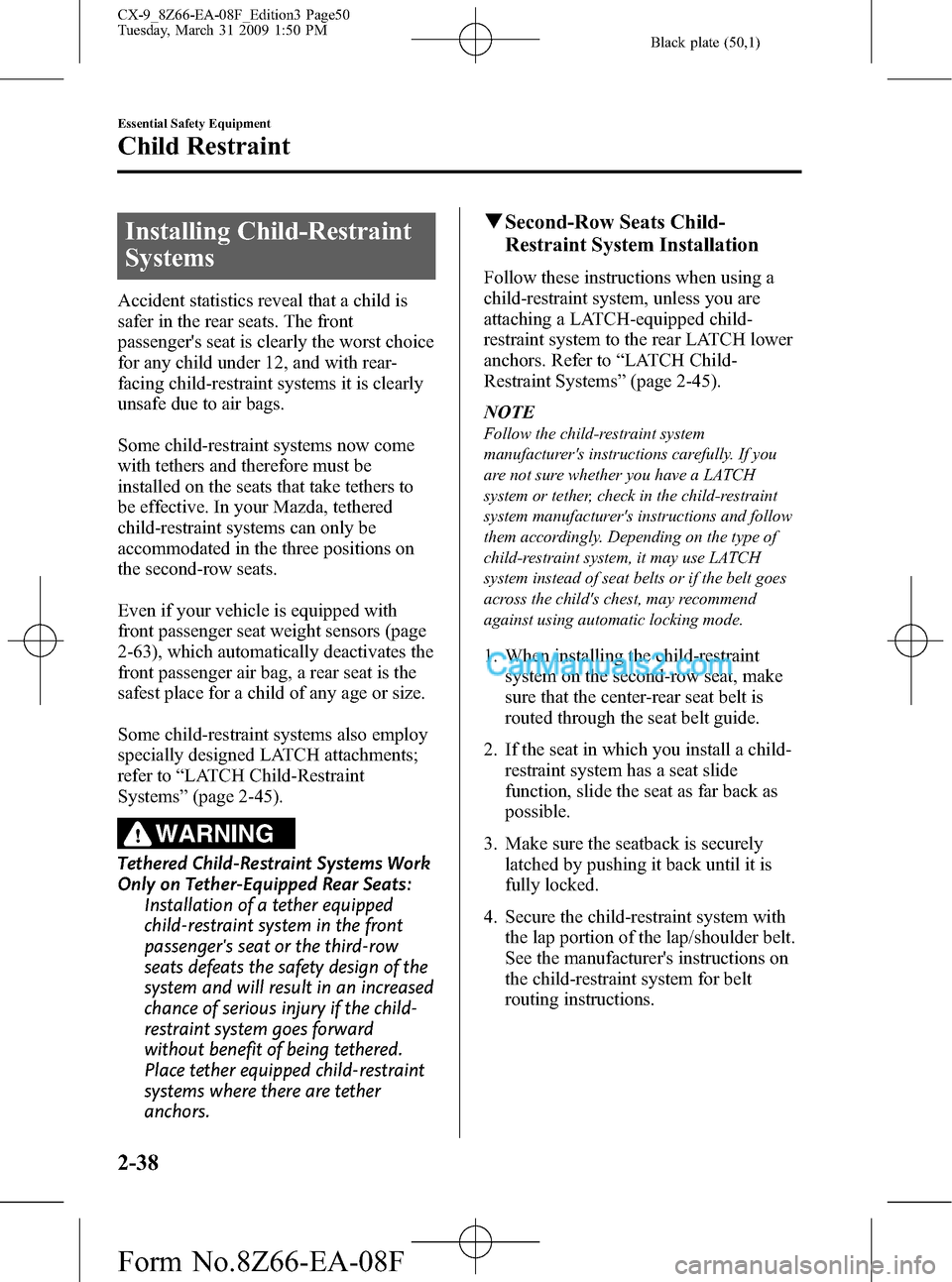
Black plate (50,1)
Installing Child-Restraint
Systems
Accident statistics reveal that a child is
safer in the rear seats. The front
passenger's seat is clearly the worst choice
for any child under 12, and with rear-
facing child-restraint systems it is clearly
unsafe due to air bags.
Some child-restraint systems now come
with tethers and therefore must be
installed on the seats that take tethers to
be effective. In your Mazda, tethered
child-restraint systems can only be
accommodated in the three positions on
the second-row seats.
Even if your vehicle is equipped with
front passenger seat weight sensors (page
2-63), which automatically deactivates the
front passenger air bag, a rear seat is the
safest place for a child of any age or size.
Some child-restraint systems also employ
specially designed LATCH attachments;
refer to“LATCH Child-Restraint
Systems”(page 2-45).
WARNING
Tethered Child-Restraint Systems Work
Only on Tether-Equipped Rear Seats:
Installation of a tether equipped
child-restraint system in the front
passenger's seat or the third-row
seats defeats the safety design of the
system and will result in an increased
chance of serious injury if the child-
restraint system goes forward
without benefit of being tethered.
Place tether equipped child-restraint
systems where there are tether
anchors.
qSecond-Row Seats Child-
Restraint System Installation
Follow these instructions when using a
child-restraint system, unless you are
attaching a LATCH-equipped child-
restraint system to the rear LATCH lower
anchors. Refer to“LATCH Child-
Restraint Systems”(page 2-45).
NOTE
Follow the child-restraint system
manufacturer's instructions carefully. If you
are not sure whether you have a LATCH
system or tether, check in the child-restraint
system manufacturer's instructions and follow
them accordingly. Depending on the type of
child-restraint system, it may use LATCH
system instead of seat belts or if the belt goes
across the child's chest, may recommend
against using automatic locking mode.
1. When installing the child-restraint
system on the second-row seat, make
sure that the center-rear seat belt is
routed through the seat belt guide.
2. If the seat in which you install a child-
restraint system has a seat slide
function, slide the seat as far back as
possible.
3. Make sure the seatback is securely
latched by pushing it back until it is
fully locked.
4. Secure the child-restraint system with
the lap portion of the lap/shoulder belt.
See the manufacturer's instructions on
the child-restraint system for belt
routing instructions.
2-38
Essential Safety Equipment
Child Restraint
CX-9_8Z66-EA-08F_Edition3 Page50
Tuesday, March 31 2009 1:50 PM
Form No.8Z66-EA-08F